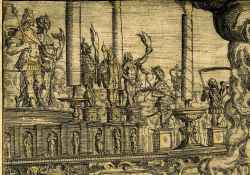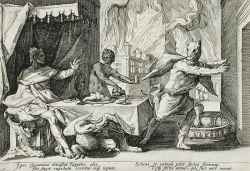Topic: 2. Sacrifice and religion: Comparisons, Antiquarians, Anthropology (16th-18th Century)
Religious sacrifices across various cultures and contexts sparked widespread interest in Early Modern Europe. As Christianity expanded into regions inhabited by "infidels" and "pagans", Europeans encountered a diverse array of sacrificial customs, ranging from the Sati rituals in India to the Aztec sacrifices in the Americas. This cross-cultural exposure captivated a wide audience, including theologians, philosophers, political thinkers, antiquarians, orientalists, missionaries, poets, artists, and even the general public. These encounters broadened the European understanding of sacrifice and led to a critical reassessment of classical and biblical sacrificial rites. This section includes:
- Sources: A selection of early modern printed materials, which include descriptions of the Americas, Asia, and Africa, alongside antiquarian and philological studies on religious sacrifice in classical antiquity and beyond. It also presents early modern works of ethnological observations and the first attempts to compare different sacrificial practices in various traditions and contexts, laying the groundwork for disciplines like the history of religions and anthropology.
- Iconographic Representations: A rich collection of images from the 16th to 18th centuries, illustrating a range of sacrificial rituals and practices as seen in different cultural and geographical contexts.
- Related Bibliography: An extensive bibliography spanning scholarly works from the 19th to 21st centuries, providing contemporary analyses and interpretations of these early studies and observations.
Ancient Sacrifice and Head of a Satyr (?th Century)
National Gallery of Art, Washington
La fenomenologia della sati nella Scommessa di Prometeo
in: Le mythe repensé dans l’œuvre de Giacomo Leopard, pp. 327-337http://books.openedition.org/pup/11256
Aix-en-Provence: Presses universitaires de Provence, 2016.
Blood Ritual in the Hebrew Bible: Meaning and Power
Baltimore: Johns Hopkins University Press, 2004.
Jewish Sacrifice : its Nature and Function (according to Philo)
in: Ancient Mediterranean Sacrifice, pp. 94-105
Oxford: Oxford University Press, 2011.
Machiavelli e gli antiquari
in: L’Europa divisa e i nuovi mondi. Per Adriano Prosperi, pp. 3-8
Pisa: Edizioni della Normale, 2011.
The Sacrifice of Iphigenia (15-16th)
from: Italy
Harvard Art Museums/Fogg Museum, Gift of Richard Wheatland Object Number 1943.1841
De deis gentium varia & multiplex historia
Basel: Oporinus, 1548.
Violence and the Sacred
Baltimore: The Johns Hopkins University Press, 1981.
Le Kurban Bayramı à Istanbul. Le sacrifice entre commercialisation et humanitarisation
in: Un Moyen-Orient ordinaire: entre consommations et mobilités, pp. 206-232
: , .
Iphigénie de la Grèce antique à l'Europe des Lumières
Paris: Presses universitaires de France, 1985.
Saxons worshipping their gods; the deities on a temple structure on l, priests dressed as bishops on r, smoke rising from sacrifices at centre. (1597)
from: Illustration to Peter Albinus, 'Außzug der Eltisten und fürnembsten Historien des uralten streitbarn und beruffenen Volcks der Sachssen ...', (Dresden) 1597. 1597 Hand-coloured etching and letterpress
The British Museum, London
Human sacrifice and head-hunting in North Eastern India
Gauhati, India: Lawyer's Book Stall, 1977.
Le sacrifice dans les traditions turques
in: Sacrifices en Islam: Espaces et temps d'un rituel, pp. 265-285 [open access]
Paris: CNRS, .
Lycaon Transformed into a Wolf (1589)
from: Metamorphoses by Ovid, book 1, plate 9
Los Angeles County Museum of Art
Fathers and sons, sacrifice and substitution: mimetic theory and Islam in Genesis 22 and Sura 37
in: Mimetic theory and Islam: “the wound where light enters”, pp. 65-85
Cham: Springer, 2019.
Un texte grec relatif à l’Ashvamedha
in: Extract de “Journal Asiatique”, v. (1930), issue : pp..
Des Herrn Racine Trauerspiel Iphigenia, vor einigen Jahren ins deutsche übersetzt, Nunmehro aber mit einer Vorrede und einem Auszuge aus der griechischen Ipigenia des Euripides ans Licht gestellet
Leipzig: Bernhard Christoph Breitopf, 1734.





